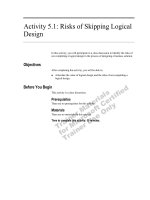Inclusive Urban Design doc
Bạn đang xem bản rút gọn của tài liệu. Xem và tải ngay bản đầy đủ của tài liệu tại đây (7.95 MB, 201 trang )
Inclusive Urban
Design
This page intentionally left blank
Inclusive Urban
Design
Streets for Life
Elizabeth Burton
and
Lynne Mitchell
AMSTERDAM • BOSTON • HEIDELBERG • LONDON • NEW YORK • OXFORD
PARIS • SAN DIEGO • SAN FRANCISCO • SINGAPORE • SYDNEY • TOKYO
Architectural Press is an imprint of Elsevier
H6458-Prelims.qxd 1/10/06 9:58 AM Page iii
Architectural Press is an imprint of Elsevier
Linacre House, Jordan Hill, Oxford OX2 8DP, UK
30 Corporate Drive, Suite 400, Burlington MA 01803, USA
First edition 2006
Copyright © 2006 Elsevier Ltd. All rights reserved
No part of this publication may be reproduced, stored in a retrieval system or transmitted in
any form or by any means electronic, mechanical, photocopying, recording or otherwise
without the prior written permission of the publisher
Permission may be sought directly from Elsevier’s Science & Technology Rights
Department in Oxford, UK. Phone: (ϩ44) (0) 1865 843830; fax: (ϩ44) (0) 1865 853333;
email: Alternatively you can submit your request online by
visiting the Elsevier web site at and selecting
Obtaining permission to use Elsevier material
Notice
No responsibility is assumed by the publisher for any injury and/or damage to persons
or property as a matter of products liability, negligence or otherwise, or from any use
or operation of any methods, products, instructions or ideas contained in the material herein.
Because of rapid advances in the medical sciences, in particular, independent verification of
diagnoses and drug dosages should be made
British Library Cataloguing in Publication Data
A catalogue record for this book is available from the British Library
Library of Congress Cataloguing in Publication Data
A catalogue record for this book is available from the Library of Congress
ISBN 13: 9-78-0-75-066458-5
ISBN 10: 0-75-066458-4
Typeset by Charon Tec Ltd., Chennai, India
www.charontec.com
Printed and bound in Great Britain
For information on all Architectural Press publications visit
our website at www.books.elsevier.com
To our inspiring mothers
Yvonne Burton and Irene Morgan
H6458-Prelims.qxd 1/10/06 9:58 AM Page v
This page intentionally left blank
Contents
Foreword ix
Preface xi
The authors xiii
Acknowledgements xv
List of figures and tables xvii
Structure of the book xxiii
Part 1 Streets for Life: Why? 1
Chapter 1 Origins of the Streets for Life concept 3
Chapter 2 The need for dementia-friendly streets 17
Chapter 3 Older people’s experiences of their local streets 33
Part 2 Streets for Life: How? 49
Introduction to Part 2 50
Chapter 4 Familiarity 51
Chapter 5 Legibility 64
Chapter 6 Distinctiveness 78
Chapter 7 Accessibility 92
Chapter 8 Comfort 104
Chapter 9 Safety 115
Part 3 Streets for Life: The Future? 129
Chapter 10 Streets for Life in practice 131
Chapter 11 Going further with Streets for Life 150
Bibliography 166
Index 172
This page intentionally left blank
Foreword
There is a broad consensus about the optimal design features of buildings for
people with dementia but the external environment has been neglected until
recently. The research on which this book is based was a brave and rare
attempt to fill this gap. This makes this book unique and especially important.
People with dementia, and others with cognitive impairment, are constantly
unnecessarily disabled by incomprehensible environments. We should do all
we can to help them remain independent by giving due thought and attention
to them. We do it for people with visual and hearing impairment and for those
with mobility problems. It is time we addressed the needs of people with cog-
nitive impairment so they can participate as fully as possible in society.
Mary Marshall
Retired Director of the
Dementia Services Development Centre
Stirling, Scotland
This page intentionally left blank
Preface
This book represents the goals and spirit of our Wellbeing in Sustainable
Environments (WISE) research unit. We formed WISE in 2004, within the
Oxford Institute for Sustainable Development (OISD) at Oxford Brookes
University. We wanted to give an identity to the research we had been doing
for the previous 10 years, and to strengthen the basis for continuing it into
the future.
Our objective at WISE is to investigate how the built environment (at all
scales from buildings to whole cities) affects the wellbeing, health and quality
of life of residents and other users. Our longer-term, more ambitious object-
ive is to help bring about a change in the way we design our homes, streets,
towns and cities. We believe sustainable development can only be achieved if
the design professions fully accept their social responsibilities and make more
use of evidence (from research and past experience) of user needs and how to
address them. There is no reason why we cannot use a scientific approach (as
other professions do) as the basis for creativity. It is becoming increasingly
clear that built environments have profound influences on people’s lives. We
therefore need to know how to deliver maximum benefits.
Obtaining this knowledge is not an easy task, and we have only just begun
to break the surface. Our research approach is novel because it seeks to identify
individual design features that have a positive or negative effect on people’s
quality of life or wellbeing, and we have devised original methods and tools for
doing this. We have developed ways of measuring built environments and
investigating people’s attitudes towards them. We always seek to generate prac-
tical guidance and recommendations. One of the reasons we have written this
book is because so many people – mainly designers and producers of outdoor
environments from all over the world – have contacted us to ask for our find-
ings leaflets and design recommendations and for more information on design-
ing dementia-friendly streets. We hope all the useful, relevant information is
here, in one place, in an easy-to-use form.
Meanwhile, there is so much more research to be done, so much
more we need to find out. We are constantly initiating new projects. We will
attempt to disseminate new knowledge as effectively and swiftly as possible.
We would be grateful for any feedback, comments or suggestions, and help
in achieving the mission of WISE. We hope you enjoy this book, and, more
importantly, we hope you can put our advice into practice.
Elizabeth Burton and Lynne Mitchell
WISE Research Unit, OISD
This page intentionally left blank
The authors
Elizabeth Burton MA (Cantab) DipArch DipUD PhD is Postgraduate
Research Tutor and Reader in the School of the Built Environment at Oxford
Brookes University. She is also Director of the Wellbeing in Sustainable
Environments (WISE) Research Unit in the Oxford Institute for Sustainable
Development. After practising as an architect and urban designer, she has now
been carrying out research on social sustainability and the built environment
for over 10 years, and has won more than £750,000 in research grants from
funders including the research councils, the Housing Corporation and NHS
Estates.
Lynne Mitchell MPhil MRTPI is a Post Doctoral Researcher and Associate
Postgraduate Research Tutor in the School of the Built Environment at Oxford
Brookes University. She is a chartered town planner and her research interests
lie in the relationships between social sustainability and the built environment.
She is a co-founder and member of the Wellbeing in Sustainable Environments
(WISE) Research Unit in the Oxford Institute for Sustainable Development.
This page intentionally left blank
Acknowledgements
We would like to thank Shibu Raman for his important role in carrying out
the research on which this book is based – we would not have been able to
carry out the spatial analyses without him. We are also very grateful to
Daniel Kozak, who kindly agreed to take most of the photographs and pre-
pare the drawings to illustrate Streets for Life, while studying for his PhD
degree. Our thanks go to the following, for contributing photographs:
Carol Dair – Figure 1.3
Kristina Stockdale Juhlberg – Figure 1.4
Shibu Raman – Figures 2.5 and 4.7
SURFACE Inclusive Design Research Centre, the University of
Salford – Figures 5.3, 8.4, 8.6 and 9.7
OPENspace, Edinburgh College of Art, Heriot-Watt University –
Figure 11.1.
We are grateful to Mary Marshall, recently retired Director of the
Dementia Services Development Centre, Stirling, for inspiring us with her
enthusiasm and expertise, and we are grateful to our colleagues here in the
Sustainable Urban Environments Group of the Oxford Institute for Sustainable
Development (OISD) (especially Katie Williams and Carol Dair) for their
ongoing support and encouragement.
Our research benefited from the advice and guidance of our steering
group and findings group, including: Professor Tim Blackman; Susan Fairburn;
Elizabeth King and staff at OPTIMA, Radcliffe Infirmary Trust; Joan King;
Tom Owen; Maria Parsons and staff at the Oxford Dementia Centre; Diana
Roberts; Dr Bart Sheehan; Dr Katie Williams; Professor Mike Jenks; Karl
Kropf; and Steve Ongeri.
Finally, we want to thank our friends and family (especially Ben and
Bart) who have been patient and encouraging during the process of writing
the book.
This page intentionally left blank
List of figures and tables
FIGURES
Figure 1.1 The WISE dementia project findings leaflet (Burton,
Mitchell and Raman, 2004).
Figure 1.2 People are ‘disabled’ by the environments provided for them.
Figure 1.3 BedZED, Sutton: one of the new sustainable developments in
the UK.
Figure 1.4 A shortage of care home places makes it vital to enable older
people to remain living in their own homes.
Figure 1.5 If older people can get out and about in their local
neighbourhoods, they are more likely to be able to remain
living at home.
Figure 2.1 Badly designed or maintained streets can be a problem for
anyone but especially for older people.
Figure 2.2 Streets also need to accommodate the needs of younger people
with physical, sensory or cognitive impairments.
Figure 2.3 Inclusive design addresses the needs of everyone.
Figure 2.4 How old is old?
Figure 2.5 The main types of illness that cause dementia.
Figure 2.6 If streets are not designed to meet the needs of older people
many, especially those who are frail or have dementia, will be
effectively trapped in their own homes.
Figure 3.1 Almost all older people, with or without dementia, regularly
go shopping.
Figure 3.2 Older people with dementia struggle to understand buildings
that do not make their purpose obvious.
Figure 3.3 Being able to accomplish a simple task is a huge boost to the
self-esteem of people with dementia.
Figure 3.4 Older people benefit in a variety of ways from fresh air and
exercise.
Figure 3.5 Older people particularly enjoy seeing greenery and trees in
their neighbourhoods.
Figure 3.6 Being able to go out gives older people the opportunity to
meet others.
Figure 3.7 A common fear for older people is that uneven or damaged
surfaces will cause them to fall.
Figure 3.8 The most commonly offered suggestion for improving local
streets was to have clearer signs – this sign is difficult for
older people to read because the graphics are too small and it
is too high.
Figure 4.1 People have a general expectation of what they will find on
main streets.
Figure 4.2 People also have a general expectation of what they will find
on side streets.
Figure 4.3 Many modern buildings present a blank façade to pedestrians
with little cues as to their identity or how to get into them.
Figure 4.4 People with dementia often do not recognise modernistic
designs or they misinterpret their usage.
Figure 4.5 Most people are familiar with the traditional red K6 telephone
box but, just in case, it also has the word ‘telephone’ in large clear
graphics on all four sides.
Figure 4.6 This modern telephone box presents a confusing array of
unfamiliar signs and symbols.
Figure 4.7 The tourist information sign – ‘any ideas?’
Figure 4.8 A hierarchy of familiar types of streets gives a clear image of
an area.
Figure 5.1 Symbols must be as clear and realistic as possible.
Figure 5.2 Multiple pointers can be ambiguous and the graphics too
difficult to read.
Figure 5.3 The UK Post Office sign, a particularly dementia-friendly
sign.
Figure 5.4 Junctions with a number of routes to choose from can be very
disorienting especially if the streets are difficult to distinguish
from each other.
Figure 5.5 The markings on this junction seem designed to help drivers
but not pedestrians.
Figure 5.6 Although the uniform grid provides a pattern of well-connected
streets the layout of identical streets and cross-roads can be as
confusing as the ‘lollipop’ pattern. The irregular grid pattern
also has small perimeter blocks and connected streets but
creates a variety of block and street shapes.
Figure 5.7 Forked, staggered and T-junctions reduce the number of
routes to choose from and provide a focus point at the end of
the street.
List of figures and tables
xviii
H6458-Prelims.qxd 1/10/06 9:58 AM Page xviii
Figure 5.8 Fairly narrow streets with gentle bends are generally more
interesting to walk along than wide, straight streets.
Figure 5.9 A legible street. The buildings face the street and have low
boundaries to delineate private space without blocking the
view. The T-junction provides buildings to focus on at the
end of the street rather than a further stretch of road and a
minimal choice of routes. Trees and a post box on the street
corner act as useful wayfinding cues.
Figure 6.1 Older people with dementia tend to prefer informal urban
open spaces to empty, formal squares.
Figure 6.2 Historic buildings make good landmarks as they are generally
noticeable and interesting pieces of architecture and are more
likely to be remembered as they have been in existence for a
long time.
Figure 6.3 Distinctive structures catch the eye and help people to identify
which way they need to go.
Figure 6.4 A practical feature that is also distinctive and attractive.
Figure 6.5 Familiar street furniture and aesthetic features positioned on
street corners provide distinctive wayfinding cues.
Figure 6.6 Gently winding streets with varied form and features are more
interesting than straight uniform streets.
Figure 6.7 People with dementia find it difficult to maintain concentration
when walking along straight uniform streets.
Figure 6.8 A skittles green in a Barcelona park – a popular place of
activity and a useful wayfinding cue.
Figure 7.1 Older people generally cannot walk as far or as fast as
younger adults.
Figure 7.2 Crowded streets can be difficult to negotiate.
Figure 7.3 Below ground toilets are inaccessible to many people.
Figure 7.4 Primary services and facilities should be within 500 m of older
people’s housing and secondary services should be within 800 m.
Figure 7.5 Wide footways provide more room for avoiding pedestrians
and obstructions than narrow footways.
Figure 7.6 Narrow footways impede accessibility.
Figure 7.7 Ideally, even small changes in level should have both a ramp
and steps.
Figure 8.1 The wooden seat with back and arm rests provides a far more
comfortable resting place than the metal bench. Litter bins
should have swing lids to protect against odours and wasps and
be emptied regularly!
List of figures and tables
xix
H6458-Prelims.qxd 1/10/06 9:58 AM Page xix
Figure 8.2 This bench could not be more un-friendly if it tried! It does
not look familiar, comfortable or even safe and is situated on
paving guaranteed to cause dizziness.
Figure 8.3 The automated ‘Superloo’ is unfamiliar and a little daunting
to many older people who will seek out more conventional
types of public toilet.
Figure 8.4 A conventional type of public toilet. [Photograph by
SURFACE Inclusive Design Research Centre.]
Figure 8.5 Open spaces should have quiet, shaded seating areas.
Figure 8.6 Older people prefer enclosed bus shelters with seating and
transparent sides or large windows.
Figure 9.1 Bicycles on footways are a common safety concern for older
people.
Figure 9.2 Older people find broken or uneven parking particularly
hazardous.
Figure 9.3 Cars parked half on footways are dangerous and obstructive.
Figure 9.4 Underpasses can be onerous and frightening.
Figure 9.5 These cobbled strips are a trip hazard – not only are they
slightly raised but they will look like steps to people with
impaired depth perception.
Figure 9.6 The rough surface of this paving can be difficult for older
people and others with mobility problems to walk on. The
pattern is likely to cause dizziness and confusion in people
with visual and cognitive impairments.
Figure 9.7 Older people feel safer using signal-controlled pedestrian
crossings with audible cues and visual signals on both sides of
the road than other types of crossing.
Figure 9.8 Footways should be wide with plain, smooth, level, non-slip
and non-reflective paving.
Figure 10.1 The key design features of Streets for Life.
Figure 10.2 Recommendations leaflet for housing associations, sponsored by
the Housing Corporation (Mitchell, Burton and Raman, 2004).
Figure 10.3 A mix of uses is perhaps the most fundamental ingredient of
Streets for Life.
Figure 10.4 Wide, smooth footways are a key characteristic of Streets for
Life.
Figure 11.1 We are investigating Streets for Life further through the
I’DGO (Inclusive Design for Getting Outdoors) project,
funded by EPSRC (2002–2006).
List of figures and tables
xx
H6458-Prelims.qxd 1/10/06 9:58 AM Page xx
List of figures and tables
xxi
Figure 11.2 We still need to investigate in greater detail certain aspects of
design, such as private outdoor space.
Figure 11.3 Streets for Life need to be appropriate for all ages, not just
older people.
Figure 11.4 There may be conflicts between the needs of pedestrians and
the needs of cyclists.
Figure 11.5 Streets for Life are walkable streets; sustainability objectives
require them to support public transport too.
Figure 11.6 Enjoying the outdoor environment is central to older people’s
quality of life.
TABLE
Table 10.1 Streets for Life recommendations for different implementing
bodies.
H6458-Prelims.qxd 1/10/06 9:58 AM Page xxi
This page intentionally left blank
Structure of the book
The book is arranged into three parts. Part 1 (Streets for Life – Why?), con-
taining Chapters 1–3, sets out the purpose and function of the book. It
explains what the concept of Streets for Life means, why it has been developed,
and how it fits with important issues in society today (Chapter 1). It also out-
lines the research from which the principles and recommendations for the
concept were drawn (Chapter 1). Chapter 2 explains why it is important, in
particular, to design for older people with dementia, outlining the predicted
large increases in the numbers of people with dementia in the western world.
Chapter 3 continues to focus on older people, explaining how they experi-
ence streets in their local neighbourhoods, how often, when and why they
use them, and how they feel when they are out. This forms the basis for the
following part of the book.
Part 2 (Streets for Life – How?), containing Chapters 4–9, is the main
section of the book. This is where the principles and recommendations for
designing Streets for Life are presented and explained. The recommenda-
tions are set out within the framework of six key design principles, with a
chapter devoted to each:
■ Familiarity (Chapter 4).
■ Legibility (Chapter 5).
■ Distinctiveness (Chapter 6).
■ Accessibility (Chapter 7).
■ Comfort (Chapter 8).
■ Safety (Chapter 9).
Each chapter explains what is meant by the principle and how it affects older
people and other users of neighbourhood streets. Then, we outline the
aspects of street design that can contribute to achieving the principle, and,
finally, present specific design recommendations.
Part 3 (Streets for Life – The Future?), containing Chapters 10 and 11,
concludes the book by looking at implementation of the recommendations in
practice, outlining potential barriers and possible further research (Chapter
10). Chapter 11 summarises the potential contribution of Streets for Life to
UK towns and cities and beyond, to Europe and the rest of the world,
explaining the significance and benefits of using the guidance.
We have designed the book so that readers can use the middle (Part 2)
section for reference without having to read the rest of the book.
This page intentionally left blank









